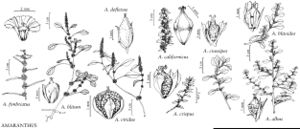Difference between revisions of "Amaranthus crispus"
in A. Gray et al., Manual ed. 6, 428. 1890.
FNA>Volume Importer |
FNA>Volume Importer |
||
| Line 8: | Line 8: | ||
}} | }} | ||
|common_names=Crisp-leaved amaranth | |common_names=Crisp-leaved amaranth | ||
| − | |basionyms={{Treatment/ID/ | + | |basionyms={{Treatment/ID/Basionym |
|name=Euxolus crispus | |name=Euxolus crispus | ||
|authority=Les pinasse & Thévenau | |authority=Les pinasse & Thévenau | ||
| + | |publication_title=Bull. Soc. Bot. France | ||
| + | |publication_place=6: 656. 1859 | ||
}} | }} | ||
|synonyms= | |synonyms= | ||
| Line 51: | Line 53: | ||
|publication year=1890 | |publication year=1890 | ||
|special status= | |special status= | ||
| − | |source xml=https://jpend@bitbucket.org/aafc-mbb/fna-data-curation.git/src/ | + | |source xml=https://jpend@bitbucket.org/aafc-mbb/fna-data-curation.git/src/f6b125a955440c0872999024f038d74684f65921/coarse_grained_fna_xml/V4/V4_843.xml |
|genus=Amaranthus | |genus=Amaranthus | ||
|subgenus=Amaranthus subg. Albersia | |subgenus=Amaranthus subg. Albersia | ||
Revision as of 20:02, 24 September 2019
Plants annual, sparsely pubescent. Stems prostrate to ascending, branched mainly from base, 0.1–0.4(–0.5) m. Leaves: petiole shorter than blade; blade rhombic-ovate to oblong, 0.5–1.5(–2.5) × 0.3–0.8(–1.5) cm, base cuneate, margins crisped-erose, conspicuously undulate, apex acute to subobtuse, with short mucro. Inflorescences axillary glomerules, green, axes not thickened, not indurage at maturity. Bracts lanceolate to oblong-lanceolate, 1.2–1.7 mm, ± equaling or slightly shorter than tepals. Pistillate flowers: tepals 5, spatulate-oblong, equal to subequal, 1.2–1.7 mm, margins entire, apex rounded to subacute; style branches spreading; stigmas 3, sessile. Staminate flowers intermixed with pistillate; tepals 5; stamens 5. Utricles ellipsoid or obovoid, 1.5–2 mm, slightly longer than tepals, smooth to slightly wrinkled, indehiscent. Seeds black to dark reddish brown, lenticular to obovoid-lenticular, 0.7–1 mm diam., smooth.
Phenology: Flowering summer–fall.
Habitat: Waste places, other disturbed habitats, mostly at seaports and on ballast
Elevation: 0-500 m
Distribution
N.J., N.Y., N.C., Va., native to South America (Argentina), introduced in s Eurasia and other regions.
Discussion
Selected References
None.
